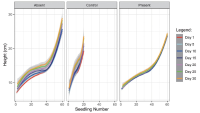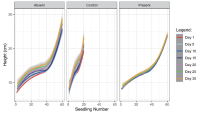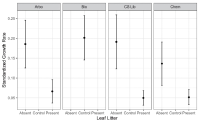
Vol.2 No.2

Abstract
With continuous decline of Philippine forest cover, sustainable forest management and restoration are essential to restore destroyed forest ecosystems. Unfortunately, of ten most planted trees in reforestation projects in the Philippines, eight are exotic species, with large leaf mahogany (Swietenia macrophylla) being the most dominant. In this study, effect of Swietenia macrophylla in reforestation projects on native tree species was evaluated. Effects of S. macrophylla leaf litter, frequency, and canopy closure on the growth of the Philippine native species Pterocarpus indicus were investigated. Results showed that S. macrophylla leaf litter significantly inhibited the growth of P. indicus seedlings based on root collar-to-shoot height. The standardized growth rate of seedlings in plots without S. macrophylla leaf litter was significantly higher than the growth rate of seedlings in plots with leaf litter. Furthermore, there was no significant difference in the standardized growth rate of seedlings between plots without leaf litter and a control plot. On the contrary, S. macrophylla tree frequency and canopy closure showed no significant effect. These results attest to the negative effect of widely planted S. macrophylla to a valuable Philippine native tree P. indicus. With accumulating scientific evidence about negative effects of S. macrophylla on native trees, discontinued use in tree planting and reforestation efforts with active management of restoration sites previously planted with large leaf mahogany are needed.







Abstract
Current international negotiation and cooperation for sustainable development are focused on three main themes. The first theme is implementation of Sustainable Development Goals (SDGs). The second theme is development of measures for climate change. The third theme is sustainable management of biodiversity and ecosystem services. In South Korea, responses of government policies and academic studies have been predominantly to one of these three themes. There have not been many integrated efforts to develop countermeasures considering all three international themes. In addition, while “green growth” policies have been setting national agendas for Korea’s sustainable development, they must be scrutinized such as why they have not dealt with some parts of these three themes and whether they have ignored one of these themes due to lack of integrated responses. This study finds critical issues in South Korea on how to harmoniously respond to the three themes of international efforts and improve green growth policies. First, to achieve SDGs, the domestic statistical system must be reorganized to track the achievement of “inclusiveness” and “green growth”. Second, the climate change response policy should seek inclusion between countries and between social groups. Third, in the field of biodiversity and ecosystem services, it is necessary to establish Korea’s identity in global geopolitics and enhance its own traditional ecological knowledge. Fourth, it is necessary to consider how to solve discrepancy between climate change response policies and biodiversity-ecosystem service management policies. Finally, proactive improvement of laws and institutions must occur to promote inclusive green growth.








Abstract
The era of mass production of agricultural and dairy systems inevitably causes a huge amount of biowastes during their processes. Modern consumption patterns of the general public also contribute to biowaste formation. Thus, processing biowastes has attracted much attention. The introduced black soldier fly (BSF) (Hermetia illucens) is considered as one of environmentally friendly management options for solving biowaste issues. However, an indigenous species, Ptecticus tenebrifer, is also a powerful decomposer that has been largely neglected. This species can be easily found on biowastes such as manure dump, agricultural wastes, and human food wastes. It can be also easily found in the field. It is even attracted to a food trap. To the best of our knowledge, this is the first ecological study on this species.



Abstract
The objective of this study was to analyze social wasps’ urban distribution tendency based on 10 species found in two metropolitan cities (Busan and Daegu) of South Korea. There 10 species included six species (Vespa mandarinia, V. ducalis, V. crabro flavofasciata, Vespula koreensis koreensis, Parapolybia indica, and Polistes snelleni) of forest dwellers that inhabited urban main forests and satellite forests, two species (V. simillima simillima and V. analis parallela) of facultative dwellers that nested at diverse sites of urban areas with greater preference for urban forest, and two species (V. velutina nigrithorax and P. rothneyi koreanus) of urban dwellers that nested at almost all sites, including urban and forest areas. These urban dwellers were found to adapt well to an urban environment based on their far higher rate of urban nesting compared to facultative dwellers. When distribution tendencies of facultative dwellers and urban dwellers in Busan and Daegu were compared, a regular distribution was mostly observed in Busan with a dense forest network. For Daegu that lacked forest connectivity, the greatest distribution of species was found in the nearby urban forest. For Daegu, a city further away from forests, urban dwellers occurred far beyond forest sites compared to Busan with a dense forest network.





Abstract
Detrimental effects of inbreeding have been studied by many researchers for a long time. However, only a few studies have shown the occurrence of inbreeding depression due to evolutionary changes as a purging process. In this study, two different populations (inbreeding and outbreeding) of Drosophila melanogaster were compared to assess inbreeding effects on artificial population bottlenecks. For inbreeding conditions, a couple of D. melanogaster (one virgin and one male) were selected from an inbred population and cultured in a vial. For outbreeding conditions, a couple of D. melanogaster were selected from different populations and cultured in a vial. There were significant differences in body lengths of adults, but not in other parameters such as the total number of adults, the rate of survival, and the rate of wing mutants. The mean body length of adults of outbreeding populations was longer than that of inbreeding populations in the first generation (G1; P = 0.004), but not in the second generation (G2; P = 0.066). Although the other three parameters (total number of adults, rate of survival, and rate of wing mutants) showed differences in their mean values between inbreeding and outbreeding populations, these differences were not statistically significant. This might be due to genetic purging. This study demonstrated one additional experimental case related to inbreeding depression in artificial bottlenecked populations. Further studies are necessary to confirm the clear interaction between inbreeding depression and genetic purging using more generations and replicates (or samples) of D. melanogaster.



Abstract
To restore the Gold-spotted pond frog (Pelophylax chosenicus), a Korean endangered frog, 600 captive-reared individuals were reintroduced between August and September 2019 into an aquatic garden in the National Institute of Ecology where P. chosenicus had previously inhabited. After reintroduction, six post-release monitoring sessions were conducted from August 2019 to May 2020. Monitoring was performed using three methods (counting calls, observation, and capture) from sunset to midnight near release sites, eliminating potential threat factors. Snout-vent lengths and body weights of recaptured individuals were measured before they were released immediately. We noted that both snout-vent lengths and body weights of recaptured individuals were slightly higher than those before. The average recapture rate was 4.66%. Reintroduced frogs were recaptured at the last monitoring session conducted in May 2020, indicating that these reintroduced frogs hibernated during the winter successfully. We found that these reintroduced frogs successfully settled after release. This result will be useful for establishing management strategies for endangered frogs in Korea. Particularly, post-release monitoring could be an essential approach in the restoration program of a target species.




Abstract
The objective of this study was to analyze the genotype of black-spotted pond frog (Pelophylax nigromaculatus) using seven microsatellite loci to quantify its genetic diversity and population structure throughout the spatial scale of basins of Han, Geum, Yeongsan, and Nakdong Rivers in South Korea. Genetic diversities in these four areas were compared using diversity index and inbreeding coefficient obtained from the number and frequency of alleles as well as heterozygosity. Additionally, the population structure was confirmed with population differentiation, Nei’s genetic distance, multivariate analysis, and Bayesian clustering analysis. Interestingly, a negative genetic diversity pattern was observed in the Han River basin, indicating possible recent habitat disturbances or population declines. In contrast, a positive genetic diversity pattern was found for the population in the Nakdong River basin that had remained the most stable. Results of population structure suggested that populations of black-spotted pond frogs distributed in these four river basins were genetically independent. In particular, the population of the Nakdong River basin had the greatest genetic distance, indicating that it might have originated from an independent population. These results support the use of genetics in addition to designations strictly based on geographic stream areas to define the spatial scale of populations for management and conservation practices.







Abstract
Living modified organisms (LMOs) are managed by seven government agencies according to their use in South Korea. The Ministry of Environment is responsible for LMOs used for environmental remediation. This study aimed to develop guidelines for assessing potential risks posed by transgenic plants used for remediation to insect ecosystems by investigating arthropod communities in sunflower fields. A total of 2,350 insects and spiders belonging to 134 species of 10 orders and 71 families were collected from sunflower fields over four growth stages ranging from anthesis to seed maturity. At the R3 phase of flower-bud formation, Chironomidae sp. of a decomposer insect guild presented the highest density, while Apis mellifera of a pollinator guild was the most abundant in the R5.8 phase of flowering. During the R7 seed-filling phase and the R9 phase of seed maturity, herbivorous Pochazia shantungensis predominated. During the R9 phase, richness and diversity indices of arthropod communities were distinctly lower whereas their dominance indices were significantly higher than those at other phases. In addition, the composition of arthropod communities was strongly correlated not only with the sampling date, but also with the sampling method depending on the growth stage of sunflowers. Our results suggest that appropriate sampling timing and methods should be considered in advance and that long-term field trials that cover a variety of environmental conditions should be carried out to evaluate potential risks to insect ecosystems.




Abstract
In this study, data repository information registered in re3data (re3data.org), a research data registry, was collected. Based on collected data, the current status was analyzed for 354 repositories (approximately 14% of total repositories) in the field using keywords in the ecological field suggested by two experts. Major metadata formats used to describe data in ecological research data repositories include Federal Geographic Data Committee Content Standard for Digital Geospatial Metadata (FGDC/CSDGM), Dublin Core, ISO 19115, Ecological Metadata Language (EML), Directory Interchange Format (DIF), Darwin Core, Data Documentation Initiative (DDI), and DataCite Metadata Schema. The number of ecological repositories according to country is 102 in the US, 34 in Germany, 31 in Canada, and one in Korea. A total of 771 non-profit organizations and 12 for-profit organizations are involved in the construction of the ecological field research data repository. Data version control ratio of the ecological field research data repositories registered in re3data was analyzed to be somewhat higher (86.6%) than the total ratio (83.9%). Results of this study can be used to establish policies to build and operate a research data repository in the ecological field.

